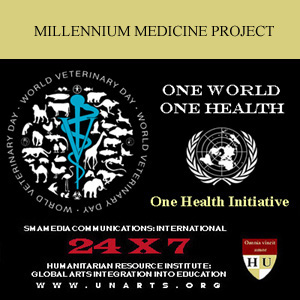7 July 2010
Humanitarian Resource Institute
Phone: (203) 668-0282
Url: www.humanitarian.net
United Nations Arts Initiative
Arts Integration Into Education
Url: www.unarts.org
Twitter: unarts
HRI:UNArts - Millennium Medicine Project
Url: www.pathobiologics.org/mmp

HRI:UNArts
- Millennium
Medicine Project
3.5 billion people live in severe poverty, 2.4
billion people lack access to basic sanitation and over 1 billion
people
lack access to safe drinking water.... Each day in the developing
world, 30,000 children die from mostly preventable and treatable causes
such as diarrhea, acute respiratory infections or malaria. [1]
In the context of the worlds most wealthy countries, according to the
"World Vision responds to G20 Communiqué" [2]:
- While
G20 leaders have been focused on finding concrete solutions to economic
challenges, almost 14,000 children in their own countries will have
died,
mostly from preventable causes.
- These
countries are now the 21st century’s economic powerhouses, with 87 per
cent of the world’s GDP, yet many are still failing to address dire
living conditions and lack of access to health services in their
communities.
The World
Health Organization Global
Initiative for Emergency and Essential Surgical Care (GIEESC) was
established in December 2005 as an international collaboration of
Ministries
of Health, WHO country offices, local and international organizations
and academia. GIEESC is involved in reducing death and disability from
road traffic accidents, trauma, burns, falls, pregnancy related
complications,
domestic violence, disasters and other surgical conditions. The
specific
objectives are:
- strengthen
capacity to deliver effective emergency surgical care at the first
referral
level facility, working towards achieving the WHO Millennium
Development
Goals
- improve
the quality of care through safe and appropriate use of emergency and
essential surgical procedures and linked equipment in resource limited
healthcare
facilities
- strengthen
existing training and education programs in safety of essential
procedures
in low and middle income countries
Today, despite the formation of GIEESC
in 2005, 5 Billion people across the globe lack access to
basic
surgical services and advanced medical technologies.
Even after half a century of independence, “not more
than 20 percent of the population has any access to….. basic surgical
services like life saving caesarian section, or a life saving repair of
typhoid perforation…” (National Human Development Report 2001). This
situation can be improved only if there is adequate number of rural
surgeons in India whose surgery is affordable and available near the
homes of the patients. -- Realising the
vital role of rural surgeons in the nation’s health care,
Dr. Gazeiry, MD., FRCS., the past Regional Director of
W.H.O. East Mediterranean Region remarked that rural surgery be made
into a specialty.
The concept of rural surgery has been developed in India in the last
thirteen years to make modern surgical care accessible to the five
billion havenots of the developing world. Only one billion out the
total of six billion population of the world has any access to the type
of surgical care seen in the hospital of Western Europe and America. In
India, out of the population of one billion as of today,
not more than 10% has any access to this type of surgical care. --
Association of Rural Surgeons in India. [3]
Strategic Planning and Development
The focus of the HRI:UNArts -
Millennium Medicine Project is G-192 unmet needs
analysis that includes (1) review of countries and emergencies [4], (2)
demographic and public health infrastructure, and
operational needs on the rural healthcare level. This information
will serve as our basis for strategic planning, NGO integrational
support, education initiatives and international appeals.
Access points for low cost
medical equipment and supplies for humanitarian operations at the rural
clinic
level is a priority focus [5] Current discussions include access
to:
- Low
cost diagnostics technologies (including PCR) to assist with
surveillance, containment
and control of high consequence pathogens. [7]
- Ultrasound
Technologies that include Low-Cost USB-based Ultrasound Probes and
Ultrasound
imaging and training for FAST (Focused Assessment with Sonography for
Trauma),
and early diagnosis of developmental dysplasia of the hip (DDH). [6]
- Low
cost access to pharmaceuticals, to address public health challenges
classified
under the umbrella of an international public health emergency.
[8]
- Low
cost JESS/FIX CLIP Technologies: Orthopedic supplies for
rural surgeons. [6]
For
corporations, physicians, veterinarians, scientists that would
like to serve in an advisory or product development role (included in
the Millennium
Medicine Project medical equipment and
supplies
portal), contact
Stephen
M. Apatow
Founder,
Director of Research & Development
Humanitarian
Resource Institute
Humanitarian University
Consortium Graduate Studies
Center
for Medicine, Veterinary Medicine & Law
Phone:
203-668-0282
Email:
s.m.apatow@humanitarian.net
Internet:
www.humanitarian.net
Pathobiologics
International
Internet:
www.pathobiologics.org
Humanitarian
Intervention Initiative
Operational
Security Consultancy
Internet:
www.H-II.org
References:
1. The Ultimate Objective: Humanitarian Resource Institute. Url: http://www.humanitarian.net/interfaith/studycenter/Omnia_vincit_amor
2. World Vision responds to G20 Communiqué: 27 June 2010. Url: http://www.wvi.org/wvi/wviweb.nsf/maindocs/
A52C3000496FA92A882577500003F68D
3. Association of Rural Surgeons in India. Url: http://www.arsi-india.org/
4. Reliefweb: Countries and Emergencies. Url: http://www.reliefweb.int/rw/dbc.nsf/doc401?OpenForm
5. 42 Extremely Affordable Global Health Innovations: Global Health
Ideas. http://globalhealthideas.org/2009/07/42-extremely-affordable-global-health-innovations
6. Orthopedics: Millennium Medicine Project, 6 July 2010. Url: http://www.unarts.org/mmp/orthopedics_762010.html
7. Public Health Infrastructure and Emerging Infectious Diseases:
Millennium Medicine Project, 6 July 2010. Url: http://www.unarts.org/mmp/eid_762010.html
8. Declaration/Scope - International Public Health Emergency:
Pathobiologics International, Nov. 2006. Url: http://www.pathobiologics.org/btac/UNIHR1292007.html
|